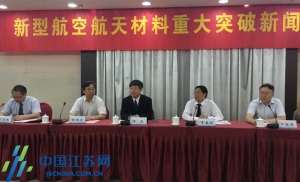China’s New Aircraft Engine Alloy Enables J-20 to Defeat F22
Posted: June 24, 2016 Filed under: Uncategorized | Tags: aircraft engine, aircraft engine material, China, F22, J-20, PST TiAl 7 Comments
Prof. Chen Guang (in dark suit) at press conference on China’s major breakthrough in aviation and aerospace materials
China has developed a much better aircraft engine alloy that will enable its J-20 stealth fighter jet to defeat US F22 and dominate the air.
China’s news.ifeng.com posted a report on June 22 on Professor Chen Guang’s success in developing an aircraft engine material much better than US best alloy for aircraft engine. Chen has achieved the success through long-term research with the funding from Nanjing Polytechnic University and the state’s Program 973.
Prof. Chen’s achievement, Polysynthetic twinned TiAl (PST TiAl) single crystals for high-temperature applications, was published on the Internet at Natural Materials on June 20.
When US GE’s new material Ti-48Al-2Cr-2Nb (Alloy 4822) was used in its GEnx engine for Boeing 787, it was hailed as a sensational success in the development of aircraft engine materials as it reduces the weight of an aircraft engine by 200 pounds, fuel consumption by 20% and discharge of NOx by 80% and significantly lowered engine noise.
At room temperature, PST TiAl has high tensile ductility of 6.9%, yield strength of 708 MPa and tensile strength of 978 MPa, a wonderful combination of ductility and strength.
What is more important for aircraft engine alloy, at the high temperature of 900℃ its yield and tensile strength is still as high as 637MPa and it has wonderful creep resistance. Its minimum creep rate and lasting life are better than Alloy 4822 by one to two magnitudes. It is hopeful that the allow may be used above 900℃ much higher that the 650~750℃ for Alloy 4822.
Source: news.ifeng.com “China makes major breakthrough in aircraft engine material with lasting life better than US material by 2 magnitudes” (summary by Chan Kai Yee based on the report in Chinese)
Another milestone for China’s Brainwave – Excellent news.
LikeLike
I do not understand. U claimed for few years that China is making huge progress regarding its indigenous jet engines. Nevertheless, for the J-10B, and J-11’s fleet, China continues to buy russian engines. Some chinese squadrons were grounded because of lack of chinese’s engines reliabilities. It seems only 24 J-15 were ordered until now. 24 j-16 too.
Am I correct ?
Regards
LikeLike
There are various types of turbofan jet engine. Many uses different systems and calibrations for by-pass ratio for power, endurance and quietness for stealth.. In the past, China had mastered the production for first and second generation turbofan engines. First generation turbofan engine was commonly used on American F-86 or Soviet MiG-15 or Chinese J-6, while the second generation turbofan was commonly used on American F-4 or Soviet MiG-21 or Chinese J-7/J-8. China managed to make improvement to make its turbofan engines the best developed compared to American and Soviet, but those aircrafts are obsolete in today’s military. Due to the turmoil on the 1970s, and economic reformation on the 1980s, China did not develop third generation engine. When turbofan engine development resumed on the turbofan engine in the early 2000s, China decided to develop both third and fourth engines together. However it appeared that China focused on developing fourth engine in the expense of third generation engine. In the end, China just copied the third generation engine, which resulted on inferior engines. Due to cheap third generation engine source from Russia, and the fact that third generation engine would soon be obsolete as well, China seems reluctant to improve its third generation engines, instead focuses its resources on development of its fourth generation engine. Hence China outsources engines from Russia out of convenience rather than necessity. The American was terribly shocked when China, which they deemed unable to develop third generation aircraft, manage to develop J-20 fourth generation aircraft with sound design. Their only logical explanation was through espionage, although at the time, the American F-35 was still on the drawing board. The fact is, that the F-35 and J-20 are in similar state of development, working units without appropriate fourth generation engines. Since there is no successfully working fourth generation engines today, it is hard to measure the success of chinese until it reaches operational application. The American has obviously failed to develop fourth generation engine for its F-35, while Russian engine is still experimental. The American may promote its F-22 engine as ‘fourth generation’, but it is only improved third generation engine, which at best can only be classified as third/fourth generation hybrid.
LikeLiked by 1 person
Thx Joseph for these useful explanations. Do you think that WS-15 will be operational soon on J-20 ? And indigenous WS-13 on J-31 ? Can China develop jet engines like thrust vector soon ?
LikeLike
We can only wait and see. Looking at this article, it appears that developing new engine will depend on developing new alloy material. It was not a coincidence that the American failed to develop engine for F-35. The American was usually pissed when China put quota for rare earth export. The key may lay on rare earth to develop new alloy material. Since China block the export of rare earth, the F-35 project had no way to proceed. China, on the other hand, had abundant supply of rare earth.
LikeLiked by 1 person
Actually America has also abundance of rare earth. Just that they figure why ruin their environment when the Chinese will so willingly ruin theirs.
LikeLiked by 1 person
The real reason why America cannot use its rare earth deposits is that it lacks the technology of processing the rare earth elements into useful end products. It is only China at the moment that has mastered the technology of processing rare earth metals.
LikeLike